
“That park was one of the best gathering points of our city, literally just before it closed,” said underU4Men owner Steve Lien, who has had a ringside view of O’Bryant Square for the last 18 years.
Kristian Foden-Vencil / OPB
From a spot right next to O’Bryant Square in downtown Portland, the store underU4men sells colorful underwear, resort clothing and bondage gear.
Owner Steven Lien also watches the deterioration of what was once one of the city’s crown jewels.
“That park was one of the best gathering points of our city, literally just before it closed,” said Lien, who has enjoyed, and sometimes suffered through, a ringside view of O’Bryant Square for the last 18 years.
Lien said he’s seen people taking drugs in the park and sleeping there. But he remembers the joyful gay pride parades by the park, the mobile piano singalongs and the lunchtime crowds that used to pack the space.

underU4Men store owner Steven Lie, remembers before O'Bryant Square was fenced off.
Kristian Foden-Vencil / OPB
“We had the food courts around it, of course, one of the largest pods in the city. On some days as many as 3,000 people would eat their lunch in O’Bryant Square,” he said.
This summer, the square will be demolished. The old fountain, the bricks and the underground parking garage will be broken up, dragged away and replaced by a simple grass-covered plaza.
City leaders are open to other, potentially more exciting ideas for how to use the park space. But supporters aren’t sure how to address the fact that O’Bryant Square is located right where Oregon’s richest and poorest come together.
The square opened to great fanfare in 1973. People loved the innovative dual use with a park on top and a parking garage underneath. Advertisers in The Oregonian boasted of “office space on O’Bryant Square.”
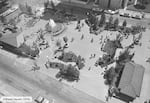
A historic picture of O'Bryant Square in the 1970s.
Courtesy: Portland Parks Foundation
But Randy Gragg, the executive director of the private nonprofit Portland Parks Foundation, said a cascade of unrelated events led to its demise.
First came the 1984 opening of nearby Pioneer Courthouse Square, which has so many events it’s become known as Portland’s living room.
“It had a nonprofit that was devoted to programming it, all the time,” Gragg said. “It just sort of sucked the energy away from O’Bryant Square.”
After that, O’Bryant’s fountain began to fail, and water started leaking into the underground parking lot. Then a large interior wall started to crumble. It had been retained from a previous structure.
On top of that, O’Bryant is located next to a spot where fiber-optic cables from across the nation converge. So the surrounding office blocks have blank, windowless walls and many are filled with computers rather than people. That reduced the number of “eyes on the street,” and the ensuing deterrent on illicit behavior out in the open. “It’s designed in such a way that it offers a lot of hiding places,” Gragg said of the park.
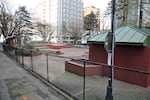
The walls of several office blocks around O'Bryant Square don't have windows, because they're computer farms for fiber optic cables.
Kristian Foden-Vencil / OPB
“It became a skateboarders’ paradise … but it also became a place where people could take drugs and deal drugs very easily,” Gragg said.
Over the years, the park gained an unfortunate reputation; some neighbors took to calling it “Needle Park.” A growing number of people avoided the square.
In 2018, it was fenced off, and this month Portland’s leaders voted to demolish the square completely.
“O’Bryant Square has deteriorated to a point where the site presents a threat to public health, welfare and safety,” Portland Mayor Ted Wheeler said at a City Council meeting on April 12.
This summer, crews will break up and remove the old concrete, then fill in the resulting hole to grade level. A ring of surrounding mature trees will remain, but the land will be just flat grass.
Gragg said the Portland Parks Foundation has run a series of community discussions about what kind of new park might be built. But they’re going to take their time.
“We’re going to try out some things, see what works, and allow that to inform the permanent design when that happens,” he said.
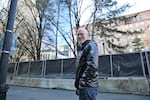
Randy Gragg, outside the fenced-off O'Bryant Square, April 12, 2023. “It’s designed in such a way that it offers a lot of hiding places,” said Gragg, who leads the private nonprofit Portland Parks Foundation.
Kristian Foden-Vencil / OPB
The issue, again, is O’Bryant’s location.
On one side of the park sits Multnomah County’s Behavioral Resource Center, where people experiencing addiction or mental health challenges can receive services. On the other side, Ritz Carlton is about to open a new, $600 million, high-rise hotel. The new building will include homes selling for as much as $7 million.
“It’s a very difficult social environment,” Gragg said. “You’ve got the extremes of society here.”
Lien, the underwear store owner, thinks event programming may be the key to reinvigorating the park and balancing the realities of Portland’s wealth divide.
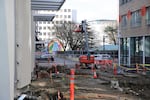
The unfinished plaza outside the new Ritz Carlton Hotel, which will lead right to the new park at O'Bryant Square. April 12, 2023.
Kristian Foden-Vencil / OPB
For example, he said, the park used to host weekly meals for people experiencing homelessness called Potluck In the Park.
“What if that was back, but now we have a volunteer group that’s actually from the residents of the Ritz Carlton?” Lien said. “Maybe the residents of the Ritz Carlton get to walk their dogs at an amazing fun little off-leash area, but there’s also the Humane Society showing up with dogs and the cats [for adoption].
“So programming is the essence of getting the community involvement that we’re going to need to have a successful park.”
The simplified park will likely reopen by the fall.
The city has put $4 million aside for new construction. It’s not enough to build something like nearby Director Park, with its overhanging glass roof and giant chess board. But if boosters can catch people’s imagination, they might be able to find more money.
Meanwhile, whoever renames the new park might pick someone to honor other than Hugh O’Bryant. He was Portland’s first mayor, back in 1851.
While he had big plans to lay roads, build jails and purchase a fire engine, none came to fruition as his tenure lasted just one year.
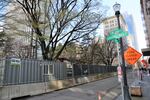
O'Bryant Square is currently fenced off. April 12, 2023.
Kristian Foden-Vencil / OPB
